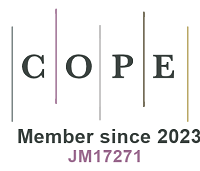REFERENCES
1. Gautam PK, Gautam RK, Banerjee S, Chattopadhyaya MC, Pandey JD. Heavy metals in the environment: fate, transport, toxicity and remediation technologies. Available from: https://www.researchgate.net/publication/314465070 [Last accessed on 27 Mar 2023].
2. Liu J, Liu YJ, Liu Y, Liu Z, Zhang AN. Quantitative contributions of the major sources of heavy metals in soils to ecosystem and human health risks: a case study of Yulin, China. Ecotoxicol Environ Saf 2018;164:261-9.
3. Ali I, Burakov AE, Melezhik AV, Babkin AV, Burakova IV, Neskomornaya ME, Galunin EV, Tkachev AG, Kuznetsov DV. Removal of copper(II) and zinc(II) ions in water on a newly synthesized polyhydroquinone/graphene nanocomposite material: kinetics, thermodynamics and mechanism. ChemistrySelect 2019;4:12708-18.
4. Liang W, Dai C, Zhou X, Zhang Y. Application of zero-valent iron nanoparticles for the removal of aqueous zinc ions under various experimental conditions. PLoS One 2014;9:e85686.
5. Madhu PM, Sadagopan RS. Effect of heavy metals on growth and development of cultivated plants with reference to cadmium, chromium and lead–a review. Available from: https://cyberleninka.ru/article/n/effect-of-heavy-metals-on-growth-and-development-of-cultivated-plants-with-reference-to-cadmium-chromium-and-lead-a-review [Last accessed on 27 Mar 2023].
6. Ali J, Khan S, Khan A, Waqas M, Nasir MJ. Contamination of soil with potentially toxic metals and their bioaccumulation in wheat and associated health risk. Environ Monit Assess 2020;192:138.
7. Sandeep G, Vijayalatha KR, Anitha T. Heavy metals and its impact in vegetable crops. Available from: https://www.researchgate.net/publication/341508109 [Last accessed on 27 Mar 2023].
8. Panfili I, Bartucca ML, Ballerini E, Del Buono D. Combination of aquatic species and safeners improves the remediation of copper polluted water. Sci Total Environ 2017;601-602:1263-70.
10. Yan W, Ramos MAV, Koel BE, Zhang W. As(III) sequestration by iron nanoparticles: study of solid-phase redox transformations with X-ray photoelectron spectroscopy. J Phys Chem C 2012;116:5303-11.
11. Aydin H, Bulut Y, Yerlikaya C. Removal of copper (II) from aqueous solution by adsorption onto low-cost adsorbents. J Environ Manage 2008;87:37-45.
12. Thanh DN, Novák P, Vejpravova J, Vu HN, Lederer J, Munshi T. Removal of copper and nickel from water using nanocomposite of magnetic hydroxyapatite nanorods. J Magn Magn Mater 2018;456:451-60.
13. Hosseinzadeh H, Ramin S. Effective removal of copper from aqueous solutions by modified magnetic chitosan/graphene oxide nanocomposites. Int J Biol Macromol 2018;113:859-68.
14. Wang L, Li J, Wang J, et al. Green multi-functional monomer based ion imprinted polymers for selective removal of copper ions from aqueous solution. J Colloid Interface Sci 2019;541:376-86.
15. Stefaniuk M, Oleszczuk P, Ok YS. Review on nano zerovalent iron (nZVI): from synthesis to environmental applications. Chem Eng J 2016;287:618-632.
16. Mukherjee R, Kumar R, Sinha A, Lama Y, Saha AK. A review on synthesis, characterization, and applications of nano zero valent iron (nZVI) for environmental remediation. Crit Rev Env Sci 2015;46:443-66.
17. Li S, Yang F, Li J, Cheng K. Porous biochar-nanoscale zero-valent iron composites: Synthesis, characterization and application for lead ion removal. Sci Total Environ 2020;746:141037.
18. Navaei Diva T, Zare K, Taleshi F, Yousefi M. Removal of Cd2+ from aqueous solution by nickel oxide/CNT nanocomposites. Available from:https://scholar.google.com.hk/scholar?q=Removal+of+Cd2%2B+from+Aqueous+Solution+by+Nickel+Oxide/CNT+Nanocomposites&hl=zh-CN&as_sdt=0&as_vis=1&oi=scholart [Last accessed on 27 Mar 2023].
19. Lian JJ, Yang M, Wang HL, et al. Enhanced molybdenum(VI) removal using sulfide-modified nanoscale zerovalent iron: kinetics and influencing factors. Water Sci Technol 2021;83:297-308.
20. Zhao Y, Zhao Z, Song X, et al. Effects of nZVI dosing on the improvement in the contaminant removal performance of constructed wetlands under the dye stress. Sci Total Environ 2020;703:134789.
21. Liu J, Liu A, Wang W, Li R, Zhang WX. Feasibility of nanoscale zero-valent iron (nZVI) for enhanced biological treatment of organic dyes. Chemosphere 2019;237:124470.
22. Wei A, Ma J, Chen J, Zhang Y, Song J, Yu X. Enhanced nitrate removal and high selectivity towards dinitrogen for groundwater remediation using biochar-supported nano zero-valent iron. Chem Eng J 2018;353:595-605.
23. Han L, Li B, Tao S, et al. Graphene oxide-induced formation of a boron-doped iron oxide shell on the surface of nZVI for enhancing nitrate removal. Chemosphere 2020;252:126496.
24. Cao Y, Zhang S, Zhong Q, et al. Feasibility of nanoscale zero-valent iron to enhance the removal efficiencies of heavy metals from polluted soils by organic acids. Ecotoxicol Environ Saf 2018;162:464-73.
25. Huang P, Ye Z, Xie W, et al. Rapid magnetic removal of aqueous heavy metals and their relevant mechanisms using nanoscale zero valent iron (nZVI) particles. Water Res 2013;47:4050-8.
26. Calderon B, Fullana A. Heavy metal release due to aging effect during zero valent iron nanoparticles remediation. Water Res 2015;83:1-9.
27. Liang L, Li X, Guo Y, Lin Z, Su X, Liu B. The removal of heavy metal cations by sulfidated nanoscale zero-valent iron (S-nZVI): The reaction mechanisms and the role of sulfur. J Hazard Mater 2021;404:124057.
28. Lei C, Sun Y, Khan E, et al. Removal of chlorinated organic solvents from hydraulic fracturing wastewater by bare and entrapped nanoscale zero-valent iron. Chemosphere 2018;196:9-17.
29. Li Q, Chen Z, Wang H, et al. Removal of organic compounds by nanoscale zero-valent iron and its composites. Sci Total Environ 2021;792:148546.
30. Xu L, Wang J. A heterogeneous fenton-like system with nanoparticulate zero-valent iron for removal of 4-chloro-3-methyl phenol. J Hazard Mater 2011;186:256-64.
31. Abbas T, Wadhawan T, Khan A, McEvoy J, Khan E. Virgin (Fe0) and microbially regenerated (Fe2+) iron turning waste for treating chlorinated pesticides in water. J Hazard Mater 2020;398:122980.
32. Malakootian M, Daneshkhah M, Hossaini H. Removal of phosphates from aqueous solution by sepiolite-nano zero valent iron composite optimization with response surface methodology. Int J Environ Sci Te 2017;15:2129-40.
33. Pasinszki T, Krebsz M. Synthesis and Application of Zero-Valent Iron Nanoparticles in Water Treatment, Environmental Remediation, Catalysis, and Their Biological Effects. Nanomaterials 2020;10:917.
34. O’Carroll D, Sleep B, Krol M, Boparai H, Kocur C. Nanoscale zero valent iron and bimetallic particles for contaminated site remediation. Adv Water Resour 2013;51:104-22.
35. Filip J, Kolařík J, Petala E, Petr M, Šráček O, Zbořil R. Nanoscale zerovalent iron particles for treatment of metalloids. In: Phenrat T, Lowry GV, editors. Nanoscale Zerovalent Iron Particles for Environmental Restoration. Cham: Springer International Publishing; 2019. pp. 157-99.
36. Xu W, Hu X, Lou Y, et al. Effects of environmental factors on the removal of heavy metals by sulfide-modified nanoscale zerovalent iron. Environ Res 2020;187:109662.
37. Dai C, Zhou Z, Zhou X, Zhang Y. Removal of Sb(III) and Sb(V) from aqueous solutions using nZVI. Water Air Soil Poll 2013:225.
38. Wen Z, Zhang Y, Dai C. Removal of phosphate from aqueous solution using nanoscale zerovalent iron (nZVI). Colloid Surface A 2014;457:433-40.
39. Anang E, Liu H, Fan X, Zhao D, Gong X. Compositional evolution of nanoscale zero valent iron and 2,4-dichlorophenol during dechlorination by attapulgite supported Fe/Ni nanoparticles. J Hazard Mater 2021;412:125246.
40. Yang L, Steefel CI, Marcus MA, Bargar JR. Kinetics of Fe(II)-catalyzed transformation of 6-line ferrihydrite under anaerobic flow conditions. Environ Sci Technol 2010;44:5469-75.
41. He F, Zhao D, Liu J, Roberts CB. Stabilization of Fe− Pd nanoparticles with sodium carboxymethyl cellulose for enhanced transport and dechlorination of trichloroethylene in soil and groundwater. Ind Eng Chem Res 2007;46:29-34.
42. Cheng S, Liu H, Anang E, Li C, Fan X. Enhanced as(III) sequestration using nanoscale zero-valent iron modified by combination of loading and sulfidation: characterizations, performance, kinetics and mechanism. Water Sci Technol 2021;83:2886-900.
43. Cornell R. M., Schwertmann U. John Wiley & Sons 2003. The iron oxides: structure, properties, reactions, occurrences and uses.
44. Liu H, Li P, Zhu M, Wei Y, Sun Y. Fe(II)-induced transformation from ferrihydrite to lepidocrocite and goethite. J Solid State Chem 2007;180:2121-8.
45. Karabelli D, Üzüm C, Shahwan T, Eroglu AE, Scott TB, Hallam KR, Lieberwirth I. Batch removal of aqueous Cu2+ ions using nanoparticles of zero-valent iron: a study of the capacity and mechanism of uptake. Ind Eng Chem Res 2008;47:4758-64.
46. Karabelli D, Ünal S, Shahwan T, Eroğlu AE. Preparation and characterization of alumina-supported iron nanoparticles and its application for the removal of aqueous Cu2+ ions. Chem Eng J 2011;168:979-84.
47. Tarekegn MM, Hiruy AM, Dekebo AH. Correction: nano zero valent iron (nZVI) particles for the removal of heavy metals (Cd2+, Cu2+ and Pb2+) from aqueous solutions. RSC Adv 2021;11:27084.
48. Zhou YT, Branford-White C, Nie HL, Zhu LM. Adsorption mechanism of Cu2+ from aqueous solution by chitosan-coated magnetic nanoparticles modified with alpha-ketoglutaric acid. Colloids Surf B Biointerfaces 2009;74:244-52.
49. Aeppli M, Kaegi R, Kretzschmar R, Voegelin A, Hofstetter TB, Sander M. Electrochemical analysis of changes in iron oxide reducibility during abiotic ferrihydrite transformation into goethite and magnetite. Environ Sci Technol 2019;53:3568-78.
50. Chen C, Kukkadapu R, Sparks DL. Influence of coprecipitated organic matter on Fe2+(aq)-catalyzed transformation of ferrihydrite: implications for carbon dynamics. Environ Sci Technol 2015;49:10927-36.
51. Perez JP, Tobler DJ, Thomas AN, Freeman HM, Dideriksen K, Radnik J, Benning LG. Adsorption and reduction of arsenate during the Fe2+-induced transformation of ferrihydrite. Acs Earth Space Chem 2019;3:884-94.
52. Bardos P, Bone B, Daly P, Elliot D, Jones S, Lowry G, Merly C. A risk benefit appraisal for the application of nanoscale zero valent iron (nZVI) for the remediation of contaminated sites. Available from: https://www.researchgate.net/publication/264788812 [Last accessed on 27 Mar 2023].







